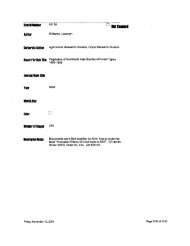Item ID Number - Special Collections
Item ID Number - Special Collections
Item ID Number - Special Collections
Create successful ePaper yourself
Turn your PDF publications into a flip-book with our unique Google optimized e-Paper software.
,. ,3t;i,,-*,i[*-i*>»^ -<br />
',.', "$&•:•" "'' *?•<br />
., *uf. ; '.Tjr • .,!«,. . u.<br />
-13-<br />
organisms, and by chemical characteristics of the pesticides. To facilitate<br />
understanding of the role of chemical nature of pesticides in<br />
determining the rate of bioconcentration, a comprehensive list has been<br />
prepared to illustrate their Important properties (Table 13).<br />
It can be seen here that general tendencies of bloaccumulation in<br />
invertebrate species follow closely the trend of the partition coefficients.<br />
In model II experiments, however, the valuos for TCDD come<br />
much lower than expected from this rule. Thus it is likely that water<br />
solubility (and solvent solubility) must play an important role where<br />
the initial pick-up is the rate-limiting factor.<br />
It is apparent that species-specific factors play a much more important<br />
role than once suspected. For instance, the pattern of bioaccumulation<br />
and concentration in fish is quite different from those<br />
in other organisms studies, in that both /"-BUG and zectran snow higher<br />
degrees of affinity than DDT and TCDD, respectively. Although the<br />
data are not sufficient to permit a definite conclusion, they suggest<br />
the possibility that water-soluble pesticides tend to accumulate in fish.<br />
TABLE 8<br />
Vertical translocation of pesticides from sand to organic soil. a<br />
Pa s t ic ide c on tent, *<br />
DDT 13<br />
Zectran"<br />
Top sand<br />
0-0.5 cm<br />
0.5-1.0 cm<br />
1.0-1.5 cm<br />
1.5-2.0 cm<br />
2.0-2.5 cm<br />
90. Ul<br />
7.32<br />
1.0U<br />
0.50<br />
0.26<br />
0.18<br />
65.01<br />
30.75<br />
3.51<br />
0.55<br />
0.26<br />
0.19<br />
0.07<br />
0.06<br />
0.08<br />
0.05<br />
0.06<br />
0.06<br />
Water eluate c<br />
1st 50 ml<br />
2nd 50 ml<br />
3rd 50 ml<br />
0.12<br />
0.08<br />
0.09<br />
0.06<br />
0.0*1.<br />
0.02<br />
1*9. U<br />
17.6<br />
29.1<br />
10 x 1.5 cm glass column<br />
Pesticide introduced: 0.1 jamole each (33-8<br />
for DDT, and 22.2 ;ig for Zectran)<br />
Water eluted per day, 50 ml<br />
for dioxin, 35.5 ;ig
















